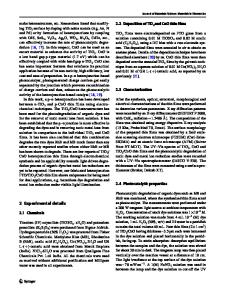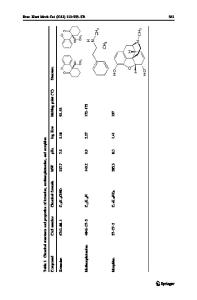Photocatalytic degradation of the acetaminophen by nanocrystal-engineered TiO 2 thin film in batch and continuous system
- PDF / 375,617 Bytes
- 4 Pages / 595.276 x 785.197 pts Page_size
- 41 Downloads / 269 Views
SHORT COMMUNICATION
Photocatalytic degradation of the acetaminophen by nanocrystal-engineered TiO2 thin film in batch and continuous system Reza Katal1, Mohammad Tanhaei2, Jiangyong Hu (✉)1 1 Department of Civil & Environmental Engineering, National University of Singapore, Singapore 117576, Singapore 2 Institute of Materials Research and Engineering, Agency for Science, Technology, and Research, Singapore 138634, Singapore
HIGHLIGHTS
GRAPHIC ABSTRACT
• Photocatalytic activity was improved in TiO2 thin film by rapid thermal annealing. • Photoreactor was designed for TiO2 thin film. • Considerable reusability and durability of prepared photocatalysts were studied.
ARTICLE INFO Article history:
Received 15 April 2020 Revised 23 July 2020 Accepted 24 July 2020 Available online 30 August 2020 Keywords: Acetaminophen TiO2 Thin film Batch Continuous
ABSTRACT Un-biodegradable pharmaceuticals are one of the major growing threats in the wastewaters. In the current study, TiO2 thin film photocatalysts were designed by nanocrystal engineering and fabricated for degradation of the acetaminophen (ACE) in a photocatalytic reaction under UV light irradiation in batch and continuous systems. The photocatalyst was prepared by sputtering and then engineered by thermal treatment (annealing at 300°C (T300) and 650°C (T650)). The annealing effects on the crystallinity and photocatalytic activity of the TiO2 film were completely studied; it was found that annealing at higher temperatures increases the surface roughness and grain size which are favorable for photocatalytic activity due to the reduction in the recombination rate of photo-generated electron-hole pairs. For the continuous system, a flat plate reactor (FPR) was designed and manufactured. The photocatalytic performance was decreased with the increase of flow rate because the higher flow rate caused to form the thicker film of the liquid in the reactor and reduced the UV light received by photocatalyst. The reusability and durability of the samples after 6 h of photocatalytic reaction showed promising performance for the T650 sample (annealed samples in higher temperatures). © Higher Education Press 2020
1
Introduction
Recently, the presence of pharmaceuticals and personal
✉ Corresponding author E-mail: [email protected]
care products (PPCPs) in the aquatic environment reflected an essential issue for living organisms (Katal et al., 2018c; Jiang et al., 2019; Fan et al., 2020). For instance, ACE as a widely consumed drug in the world, due to the complexity of molecular structure as well as uncontrolled release, has been extensively spread over the natural and wastewaters
2
Front. Environ. Sci. Eng. 2021, 15(2): 27
(Cao et al., 2016). To be un-biodegradable, using conventional removal technologies for PPCPs from the water, has not been an efficient solution. Hence, powerful and state-of-the-art oxidation techniques are required for this purpose (Chang et al., 2015; Katal et al., 2019a; Yang, 2020). The application of advanced oxidation processes (AOP) for oxidation and des
Data Loading...











